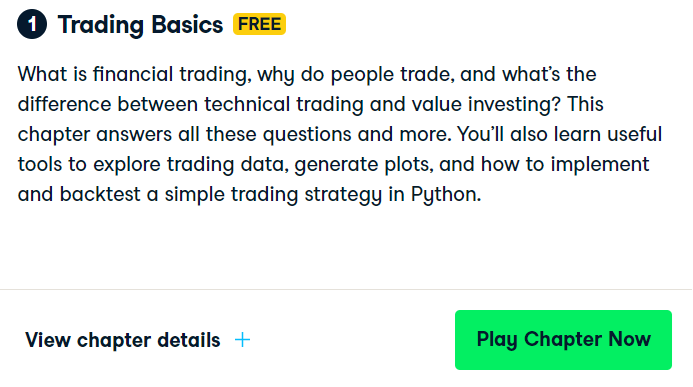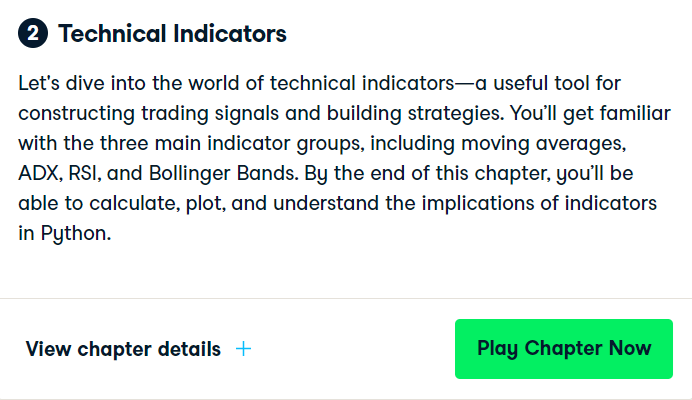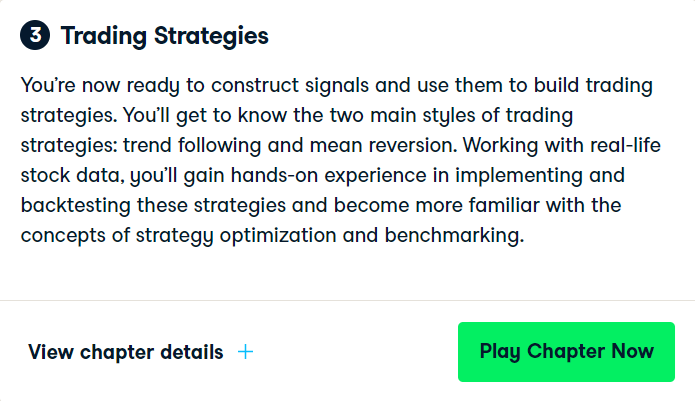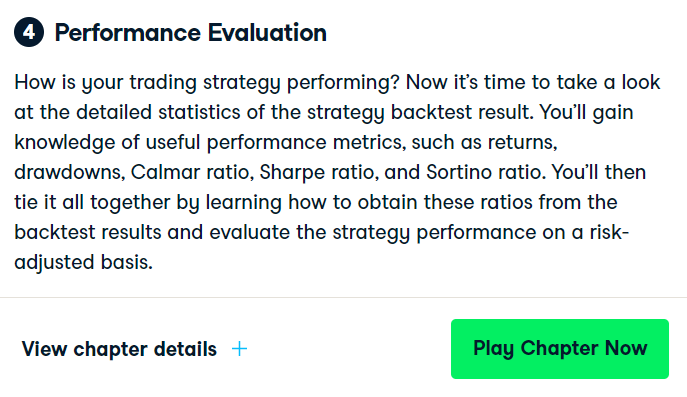Review of Financial Trading in Python
I was excited when I took the latest DataCamp.com training module called, Financial Trading in Python. At first, I thought it was going to be highly theoretical, which can be okay. But sometimes, you just want to get to the good stuff. That’s what this course will provide. Light on theory and heavy on digging in. Woohoo!
NOTE: The owner of FinancialMarketsEducation.com may receive a commission from purchases made by the links on this website.
The instructor clearly knows what she is talking about. She does have an accent, but I had zero trouble understanding her. The instructor’s name is Chelsea Yang, and she is a fantastic instructor.
NOTE: It's not necessary to click on the link in the description as the video suggests.
That is only for people viewing the video on YouTube itself!
You can take the first chapter of this course at no charge. You will have to sign up to the Data Camp service, however. If you are not familiar with Data Camp, you are in for a treat. Go ahead and sign up and take the first chapter of the Financial Trading in Python course. You’ll see exactly what I am talking about.
What You Will Learn
In the full course, you’ll learn four crucial concepts for financial trading: trading basics, technical indicators, trading strategies, and performance evaluation. Here are the modules (in order):
Did you know that Python programming skills are in high demand? Learning Python is easy when you have the right tools to teach you how. Get started with
your
free lesson today!
Try Out the First Chapter (Free)

If you are interested in implementing a trading system using Python, this is the right course to help you get started. You won’t be hammered with a lot of theory and you’ll have a solid foundation by working through this course.
DataCamp.com offers training at a premium, but the company allows students to try out the first chapter of most courses. If you are thinking of putting together a trading system, you should consider taking the first chapter. This will help you decide if you want to subscribe to finish the course (highly recommended).
In this first chapter you will learn about:
- The basics on financial data and how to create candlestick charts
- Time series data
- Resampling to different time periods
- Graphs, including histograms
- Simple moving averages (SMA)
- Using the Python bt package (basics)
The paid chapters go into greater detail on trading systems.
The DataCamp.com platform gives you all the tools you need to learn, including an environment to test out the concepts. For most courses, you’ll have a ready-made environment to try out the concepts taught. This allows you to focus on the concepts and not have to worry about configuring environments.
For this course, you’ll have direct access to a Python interpreter, and you’ll be guided on the steps to take for each exercise. You will eventually need to configure your development environments. But that is something you can tackle after your training.
Scale Up Your Learning
You have nothing to lose in taking the first chapter of this course. But if you want to learn how the foundation of a trading system, you’ll need more than just the first chapter. For instance, the second chapter covers technical analysis, which is something most trading systems use. In fact, I have seen trading system that rely exclusively on this one concept.

When implementing a trading system, you’ll start to formulate strategies. You’ll need a way to incorporate those strategies into your system. The third chapter will help you with that task. You learn how to implement signals which are the basis for a trading system to make its decisions. When a signal gets triggered, the system takes action, etc.
To round out the training, Chelsea includes a module on evaluating the performance of a trading system. This is another core feature of success with trading systems.
Comments About the Training
Overall, I am a fan of Financial Trading in Python. However, there are some areas that could be improved (nothing is perfect, right?):
- I would have liked to see a bit more instruction on how to use the bt package (backtest). There are a few concepts that are covered, but I didn’t get a good feel for why you would use WeighTargets(). The documentation online is a bit sparse.
- You won’t be able to install directly the talib package. I did state that all the training is self-contained on the Data Camp platform, and that is true. However, eventually you’ll want to experiment with the concepts learned in the training. That will require installing libraries. The bt package installs with no trouble. But talib will take a bit of effort to get it installed.
- More strategy examples would have been helpful. Hopefully, that will be the basis for a future training course by this instructor.
- If you have zero knowledge of programming or Python, you’ll probably be lost taking this class. That is not the instructor’s fault, though. My suggestion would be to start with an introduction to Python course before taking this course.
Comments About Trading Systems Overall
I truly believe that you’ll have the knowledge you need from this course (full course) to create a framework for your trading system. However, trading systems are complex and require more than a framework. Specifically, you’ll need:
- To determine your trading time frames. Decide if you are going to day trade, swing trade, or invest long-term. All are valid financial activities, but your trading system needs to reflect your decision.
- To learn a lot more than what is presented in this course. It’s a good starting point, and it doesn’t pretend to be anything but that. Trading systems often require high-end equipment. For instance, if you are day trading, you’ll need ultra-fast and reliable internet connectivity.
- To understand that Python is an interpreted language. As such, it may fall short of any system requiring low-latency access. Python has come a long way and many packages are now written using C or C++. But that doesn’t remove the constraint of interpreted Python.
- To understand that what you get out of your system depends largely on what you put into it. If you aren’t a professional programmer, you may not implement code properly and that could introduce bugs into the process. For trading systems, bugs can be quite expensive.
- To know that free financial data is often not reliable. Trading systems rely on having accurate data. If you are serious about developing a trading system, you may need to consider investing in a data service subscription.
- To be ethical when obtaining information online. The internet is a great mechanism for finding information, but you must be cautious about obtaining and sharing information. Many data providers (including Yahoo) prohibit using their data without a license. For trading on your own behalf, this should not be an issue. But if you are planning on selling your trading system, you’ll need to be aware of the pitfalls this could cause. Another issue is in using too much bandwidth of the data providers or other information providers.
Bottom Line
You won’t go wrong in taking the Financial Trading in Python course. If you work through the exercises, you’ll have a framework that you can use to build upon. I had fun taking this class and I learned a lot of useful information. And so will you.
I highly recommend the course and it serves as the basis for developing your first trading system. It takes you from saying, “I haven’t a clue how to go about implementing a trading system,” to “Hey, I now have a pretty good understanding about how this trading system stuff works!”
Learn How to Create Trading Systems Now!
Simply click on the button right below this text and take that first chapter (free) of
Financial Trading in Python! You will get as excited about the possibilities as I did.






